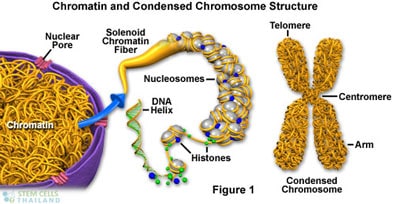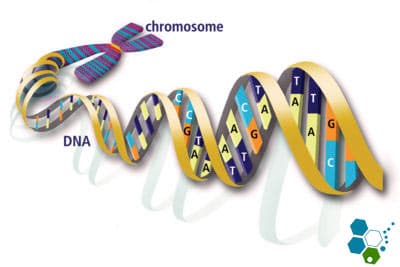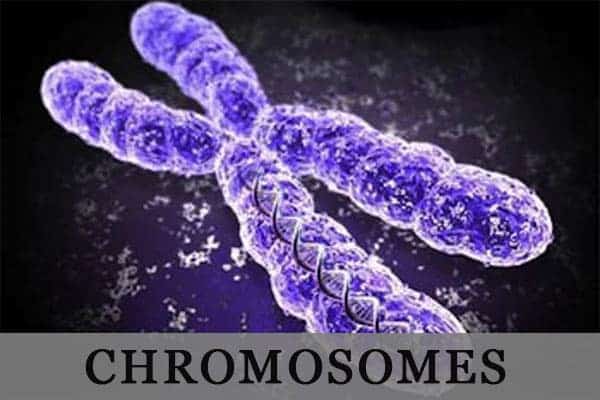Chromosomes are the building block of all life. A chromosome basically carries all of the vital information needed for our bodies to grow cells, reproduce, and survive. Chromosomes contain DNA as well as some regulatory proteins. They are normally found in the nuclei of cells. [1]
What Are Chromosomes?
There are 46 chromosomes in the human body or about 23 pairs of chromosomes. In the case of other organisms such as small peas, there are 12 chromosomes. Dogs have 78 chromosomes. This number is not related to the complexity, size, or intelligence of a particular species. [2]

Females have two X chromosomes in their cells, while males have one X and one Y chromosome. Scientists count individual strands of chromosomes. Chromosomes are made up of DNA.
The sex chromosomes are the X chromosome and the Y chromosome. Chromatin is the unit of measurement for chromosomes. Chromatin count helps display the structure of chromosomes but isn’t unique to any particular type of chromosome.
The vast majority of chromosomal abnormalities involve the sex chromosomes XX and XY—much more so than other types of autosomal abnormalities. Entire commercial industries are based on genetics and the evolution of these changes. Sex chromosome abnormalities are gender specific. XX chromosomes are markers for females, and XY chromosomes are markers for men. Most of what researchers know about chromosomes was learned by observing chromosomes during cell division and differentiation.

It’s crucial that our reproductive ancestor cells (eggs and sperm haploids) contain the exact number of chromosomes and that these chromosomes have the proper construction. [3] Haploid cells are created via meiosis, which is the opposite of mitosis. Chromosomal disorders are currently not treatable using stem cells and require gene therapies.
Chromosomes are thread-like structures located inside the nucleus of animal and plant cells. They are made of protein and a single molecule of deoxyribonucleic acid (DNA). DNA contains the specific instructions that make each type of living creature unique.
Basic Facts about Chromosome:
- Number: Humans have 23 pairs of chromosomes, for a total of 46. Of these pairs, one pair is the sex chromosomes, which determine gender. Females have two X chromosomes, while males have one X and one Y chromosome.
- Structure: Each chromosome is made up of tightly coiled strands of DNA. These strands have regions called genes, the primary genetic units that dictate how organisms inherit various features or functions.
- Centromere: The centromere is where two chromatids touch, and the microtubules attach during cell division.
- Chromatids: When a cell is about to divide, each chromosome duplicates itself to produce two identical copies, known as chromatids or sister chromatids. The two chromatids are joined at the centromere.
Chromosome Function:
- Genetic Information: Chromosomes contain genes that encode proteins, the primary workhorses within cells. These proteins determine an organism’s physical and functional traits (like eye color or metabolic processes).
- Cell Division: During cell division (mitosis and meiosis), chromosomes ensure that each daughter cell receives the correct complement of genes.
Cell Division:
- Mitosis: Mitosis is the process of cell division that produces two daughter cells with the same genetic composition as the parent cell. All chromosomes are replicated and then equally distributed to the daughter cells.
- Meiosis: Meiosis is a particular type of cell division that produces gametes (sperm and eggs in animals). In meiosis, the number of chromosomes is halved, resulting in four non-identical daughter cells, each with half the number of chromosomes of the parent cell.
Chromosomal Abnormalities:
- Changes in Number: Sometimes, during cell division, errors occur, leading to daughter cells with too many or too few chromosomes. For example, Down syndrome is caused by an extra copy of chromosome 21.
- Structural Changes: Chromosomes can undergo structural changes, like deletions, inversions, or translocations.
- Cancer: Chromosomal abnormalities can also lead to cancer. For example, the Philadelphia chromosome (chromosome 9 and chromosome 22) is a specific chromosomal abnormality associated with chronic myeloid leukemia. Learn more about genetic screening tests at the Regeneration Center.
Chromosomal Visualization:
Chromosomes can be visualized under a microscope, especially during cell division when they’re most condensed. The process typically involves staining the chromosomes to produce a pattern of dark and light bands. The resulting display is a karyotype, which can be analyzed to identify specific chromosomal abnormalities.
In summary, chromosomes are crucial in genetics, inheritance, and cellular function. They house our genes and ensure the proper distribution of genetic information during cell division.
Published Clinical Citations
[1] ^ Y. Pirson, Recent advances in the clinical management of autosomal-dominant polycystic kidney disease, QJM: An International Journal of Medicine, Volume 89, Issue 11, November 1996, Pages 803–806, https://doi.org/10.1093/qjmed/89.11.803
[2] ^ W. Reardon, C.F. O Mahoney, R. Trembath, H. Jan, P.D. Phelps, Enlarged vestibular aqueduct: a radiological marker of Pendred syndrome, and mutation of the PDS gene, QJM: An International Journal of Medicine, Volume 93, Issue 2, February 2000, Pages 99–104, https://doi.org/10.1093/qjmed/93.2.99
[3] ^ W.D. FOULKES, A tale of four syndromes: familial adenomatous polyposis, Gardner syndrome, attenuated APC and Turcot syndrome, QJM: An International Journal of Medicine, Volume 88, Issue 12, December 1995, Pages 853–863, https://doi.org/10.1093/oxfordjournals.qjmed.a069018

